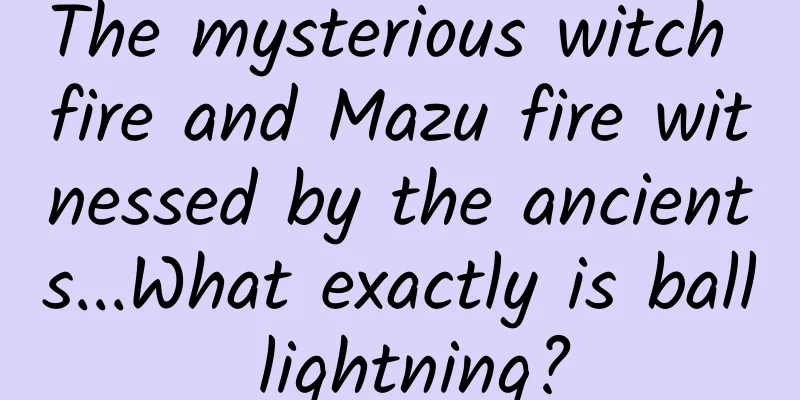The mysterious witch fire and Mazu fire witnessed by the ancients...What exactly is ball lightning?

|
This French illustration shows ball lightning entering a room through a window, a phenomenon that has been documented many times throughout history. © Alamy Stock Photo Leviathan Press: The "St. Elmo's Fire" mentioned in the article, also known as witch fire, was called Mazu Fire in ancient China. It is a natural phenomenon that has been observed by sailors during sailing since ancient times. It often occurs in thunderstorms, and produces flame-like blue-white flashes on sharp objects such as the top of a ship's mast. St. Elmo's Fire can also appear on the horns of livestock such as cattle and sheep, or on any sharp objects. St. Elmo's Fire is a corona discharge phenomenon. Due to the very large potential difference in the surrounding environment (which is very common in heavy thunderstorms), it exceeds the breakdown voltage of the air (about 3 million volts per meter), making the air a conductor (plasma) and emitting strong light in the process of conduction. On June 7, 1195, an English Benedictine monk from Canterbury named Gervase witnessed a thunderstorm descending upon the city of London. This was clearly beyond the monk's imagination: "On June 7, about six o'clock in the afternoon, a thick, dark cloud appeared over London. The cloud kept expanding, while the sun was shining brightly all around. In the middle of this cloud, there was an opening like a mill, and from nowhere a white substance emerged. The substance formed a spherical shape and was suspended between the Thames and the residence of the Bishop of Norwich. Then, a ball of fire fell into the river; it spun and landed again and again under the wall of the Bishop's house." About 400 years later, on October 21, 1638, another great storm struck the moorland town of Widecombe in Devon. Many of the townspeople were attending church services when the following unusual scene suddenly occurred: “…there was a terrible noise, and roaring of thunder, and terrible strange lightning…The whole church was instantly lit up with flashes of fire, and it was filled with smoke and an odor like that of sulfur. They saw at first a huge ball of fire coming in through the windows and passing through the church, which frightened the whole congregation so much that most of them fell down in their seats…” A later woodcut by an anonymous artist depicting the fireball at Wildcombe Church. © wikipedia According to witnesses, a "huge ball of fire" rushed through the church, destroying stones and wooden beams and setting the clothes of believers on fire. At one point, the fireball broke in two, one half smashed a window, and the other half disappeared somewhere inside the church. This killed four people and injured 60 others. The fireball left only lingering smoke and a pungent smell of sulfur. These are the two earliest records of ball lightning. Ball lightning is one of the most bizarre and rare natural phenomena. It is usually described as a floating ball of light or fire that moves around on its own and then suddenly disappears. While the first written record of ball lightning dates back only to the 12th century A.D., humans have likely encountered the phenomenon since the dawn of civilization. For example, Japanese folklore mentions "hitodama," glowing balls believed to be the spirits of the dead that follow people at night. Hermann Hendrich, Will-O-Wisp and Snake. © wikipedia Similar phenomena include the "Min Min Lights" of the Australian Outback and the "will-o'-the-wisp" of European folklore, a pale blue-green light that flickers on swamps and wetlands. However, the latter two phenomena are different. Min Min Lights may be caused by car headlights and other light sources being refracted by cold air layers; will-o'-the-wisp lights are caused by swamp gases such as phosphine, diphosphine and methane that spontaneously ignite after contact with air. This is what a will-o'-the-wisp might look like. © Sean B. Palmer Besides its rarity, another factor that makes ball lightning difficult to pin down is that it exhibits a wide variety of characteristics across different sightings. While ball lightning is usually associated with thunderstorms, it can also be seen on clear days and — interestingly — is often seen during earthquakes. Witnesses describe the balls as ranging from a few centimeters to several meters in diameter, with colors ranging from pale blue to yellow, orange, red, and even pink, and shapes ranging from spherical to oblong, disk- or rod-shaped, and multi-lobed. In many cases, the balls disappear completely silently, while other times, they make a loud buzzing or crackling sound before disappearing with a violent rumble. While ball lightning usually occurs over land, it has also been encountered at sea, as described by British sailor John Howell in December 1726: "As we were passing through Florida Bay on the 29th of August, a huge ball of fire fell from the sky, which broke our masts to pieces beyond belief; and also broke our main spars, and three planks under water, and three planks on deck. One man was killed instantly, and another had his hand blown off, and our sails would have been a ball of flame if it had not been for the heavy rain." More than twenty years later, in 1749, Dr. Gregory aboard the Royal Navy battleship HMS Montague reported the following incident: "On November 4, 1749, Admiral Chambers was on board the Montagu, when, shortly before noon, he observed a huge blue ball of fire about three miles from them. They immediately lowered the topsail, but the fireball came so fast that before they could hoist the mainsail, the fireball rose almost vertically and exploded about forty or fifty yards from the main anchor chain with a sound as if a hundred cannon were fired at the same time, leaving a strong smell of sulfur. The explosion blew the mainmast to pieces. Five men were knocked down, one of them seriously injured. Before the explosion, the fireball looked as big as a large millstone." In recent years, ball lightning has even been witnessed from aircraft, with renowned British radio astronomer Roger Clifton Jennison reporting the following sighting on March 19, 1963: "I was sitting near the front of the cabin of an all-metal airliner on a late night flight from New York to Washington. The plane encountered a thunderstorm and was suddenly enveloped by a bright electrical discharge. After a few seconds, a glowing sphere with a diameter of slightly more than 20 cm emerged from the cockpit and flew down the aisle of the aircraft, about 50 cm away from me, maintaining the same altitude and direction for the entire observable distance." Other notable figures have stumbled upon ball lightning, including British occultist Aleister Crowley and Russian Tsar Nicholas II, who witnessed the phenomenon as a child while visiting his grandfather, Alexander II, in Peterhof: "While my grandfather and I were worshipping in the chapel, a thunderstorm broke out. Lightning flashed one after another, and the thunder seemed to shake the whole world. Suddenly, the sky darkened, a gust of wind blew in through the open door, blew out the candles in front of the icon, the thunder rumbled louder than before, and I suddenly saw a ball of fire flying through the window, directly above the head of the icon. The ball (lightning) spun a circle on the ground, then flew over the chandelier, flew out of the door and into the park. My heart sank, and I looked at my grandfather - his face was unusually calm. I felt that it was inappropriate to be as scared as I was. People just need to look at what is happening and believe in God's mercy, just like my grandfather did. When the ball of lightning passed through the entire church and suddenly flew out of the door, I looked at my grandfather again. A faint smile appeared on his face and he nodded to me. My panic disappeared, and from then on, I was no longer afraid of storms." These different accounts clearly demonstrate another puzzling property of ball lightning. Sometimes these balls of light seem to have no effect on their surroundings, passing through walls and other solid objects without leaving a trace, while other times they are extremely destructive, breaking windows, starting fires, and even killing people. Even stranger, it seems to affect conductive objects far more than non-conductive ones: in many reports of ball lightning, metal objects such as electric meters and metal pipes are often violently ripped from houses and thrown into the street. Ball lightning enters the room through the fireplace, from G. Hartwig's The Aerial World, 1886. © Weather & Radar One detail that is generally consistent across reports, though, is that these balls of light often leave behind a sulfur-like odor. Although ball lightning is extremely difficult to study, it's actually not as rare as is commonly believed. In a 1960 study published in the Proceedings of the Division of Plasma Physics of the American Physical Society, J.R. McNally analyzed about 10,000 eyewitness reports and concluded that up to 5% of the world's population had seen ball lightning at some point in their lifetime. This suggests that the phenomenon is actually quite common, though the Earth is so large that it's not always possible for someone—let alone a well-trained, well-equipped scientist—to witness it in person. Some researchers get very lucky. In 1965, for example, Soviet atmospheric chemist Mikhail Dmitriev was on an expedition near Arkhangelsk in northwestern Russia when a bolt of lightning struck the ground near his camp. A fireball about 16 centimeters in diameter emerged from the lightning. It hovered for a while not far from the ground, then flew over the camp, crackling all the way. It then flew into the nearby woods and disappeared, leaving behind a wisp of dark blue smoke and a pungent smell. Dmitriev quickly used a set of vacuum bags to sample the smoke. It was later discovered that the levels of ozone and nitrogen dioxide in these samples were 50 to 100 times higher than normal. These gases are usually produced by high-voltage discharges. Airbus Captain Luis Andress captured the stunning image of St. Elmo's Fire during a flight from Miami to Denver in October 2022. © Luis Andress/SWNS In fact, ball lightning is often confused with another more common phenomenon, St. Elmo's Fire , a blue corona discharge that often appears on the masts of ships or the wings of airplanes. However, they are almost certainly different phenomena, because St. Elmo's Fire requires a sharp point or edge to overcome the breakdown potential of the surrounding air, while ball lightning is completely isolated and stable. Tesla holding a fireball, by Warwick Goble, 1899. © wikimedia Since it is extremely difficult to observe ball lightning in the wild, most research has focused on trying to replicate the phenomenon in the laboratory. One of the first to succeed was everyone’s favorite Serbian “mad” scientist, Nikola Tesla, who declared in the March 5, 1904 issue of Electrical World and Engineer magazine: "I never saw a fireball, but to make up for that I later succeeded in determining their formation pattern and creating them artificially." Newspaper reports at the time also claimed that Tesla often produced lightning balls several centimeters in diameter to please his customers. However, for Tesla, this phenomenon was just an unexpected byproduct of his research on wireless energy transmission, and he rarely discussed the topic. We have to point out that most of the media reports about Tesla at the time were highly exaggerated, so these claims should be treated with caution. Nevertheless, Tesla's tantalizing experiments still provided inspiration for later ball lightning researchers. The next important person to seriously study ball lightning was British physicist James L. Tuck. An expert in explosives, Tuck was part of the British delegation to the Manhattan Project during World War II. After the war, Tuck stayed at Los Alamos National Laboratory and was deeply involved in early nuclear fusion research. During this time, Tuck heard from many World War II submariners that they accidentally created ball lightning when they turned off the switch connecting the submarine's battery to the electric motor. These fireballs hovered above the deck for a long time, sometimes burning their legs. These stories intrigued Tuck, and he thought that solving the mystery of ball lightning might help solve another more important scientific puzzle. James Tucker's Probability Machine. © science photo At the time, most fusion research was based on the "compression" principle - using magnetic fields to confine and compress plasma, inducing atomic fusion and releasing energy. Unlike later donut-shaped tokamak reactors, early experiments did not try to confine the plasma for a long time, but rather to induce nuclear fusion as quickly as possible and collect the energy before the plasma dissipated. Unfortunately, all of the earliest experimental fusion reactions (such as Lyman Spitzer's Stellarator and James Tucker's Perhapsatron) failed again and again due to instabilities within the plasma. Lyman Spitzer's stellarator. © Princeton Plasma Physics Laboratory At the time, it was widely believed that ball lightning was also a plasma - a super-hot substance composed of hot ionized gas. But unlike stellarators and probable devices, the plasma in ball lightning was somehow able to remain completely closed and stable for several minutes. Tucker believed that finding out why might be the key to solving the problem of nuclear fusion. Fortunately, he soon found a complete submarine electrical system in the storage room of Los Alamos. Tucker persuaded a group of colleagues to install the equipment in an abandoned test bunker, and over the next two and a half years, they charged and discharged the battery thousands of times and recorded the results on film. Most experiments only produced a burst of ordinary sparks, but when reviewing the film of a certain test, Tucker found a glowing white sphere in four of the frames, about 4 cm in diameter, moving rapidly along the ground above. Unfortunately, the experimental bunker was subsequently dismantled, and Tucker was unable to continue his experiments. He retired from Los Alamos in 1973 and died in 1980 at the age of 70. Tucker shared his ball lightning photos with many people, including Robert K. Golka, an independent experimenter from Brockton, Mass. A follower of Nikola Tesla, Golka was obsessed with fulfilling Tesla's dream of transmitting electricity wirelessly around the world and developing nuclear fusion energy as the clean, unlimited energy of the future. Gorka and his Tesla coil. © rdmenzies In 1974, Gorka moved to Wendover, Utah, and settled in a 600,000 square foot abandoned hangar near the Wendover Air Force Base. Here, he assembled the world's largest Tesla coil using army surplus parts and scraps from the local junkyard. Over the next few years, he activated the giant coil several times, producing 20 million volt lightning bolts that stretched for several meters. But only on rare occasions did this impressive light show produce something resembling ball lightning. In 1980, Gorka's experiments came to an abrupt end. The Air Force, which had rented the hangar to him for a symbolic $1 per year, later transferred it to the town of Wendover, which then increased the rent by 2,400%. This triggered a long and bitter legal battle between Gorka and the town of Wendover, whose residents and government considered Gorka to be nothing more than a lunatic who got rich for nothing. Eventually, Gorka left Wendover and returned to Massachusetts, where he decided to replicate James Tucker's submarine battery experiment. But by that time, World War II submarine batteries were already quite difficult to obtain. Gorka then contacted the president of the Boston and Maine Railroad and persuaded him to provide two locomotives, several freight cars, and a mile and a half of track. Gorka wrote in the March 1985 issue of Radio Electronics: For my experiment, I connected a submarine circuit breaker to the high voltage circuit between the 1600 hp diesel generator and the 2000 hp electric motor under the locomotive. By opening the circuit breaker (using a long broom handle), I was able to generate ball lightning. The effect of opening the circuit breaker was quite dramatic. The temperature in the locomotive cab instantly rose from 60°F to 110°F. As you can imagine, one was eager to leave the cab for some fresh air. Of course, I couldn’t do that because the train was still moving (at about 20 mph) and the result would have been the train running off the track and destroying the experimental apparatus… This was probably the first plasma physics experiment ever conducted on a moving train! What a crazy guy. Based on these experiments, Gorka came to some interesting conclusions about the physics behind ball lightning: "After repeating the experiment numerous times, I finally became convinced that the fireball effect was due to the elimination of turbulence. In fact, I found that the effect was most likely to occur when I had the doors and windows of the cockpit closed... I now think that it is more like a swirling stream of particles than a high-voltage electrostatic effect; that is, more like a giant plasma vortex donut with a small hole in the middle than an electrostatic sphere. Now, there are many phenomena in aeronautical engineering, especially in fluid dynamics, that are not fully understood. One of them is the physics of vortices. One can blow a smoke ring inside another, and the inner ring can move back and forth. You can also blow a smoke ring that is stationary. In liquids, the rings can form spheres and other shapes." Gorka continued to experiment with ball lightning, wireless energy transfer, fusion, and other projects—scrambling to scrape together funding and equipment as best he could—until his death in 2018 at the age of 80. It’s important to note here that as an unaffiliated independent researcher and member of the “fringe science” community, Gorka’s methods and conclusions should be viewed with a certain amount of skepticism. © Weather & Radar The fact that for decades, only fringe scientists like Gorka were studying ball lightning meant the subject was unfortunately embroiled in pseudoscience. For example, one popular account claimed that one of James Tucker's submarine battery experiments ended in an explosion that completely destroyed the test bunker - an explosion far out of proportion to the trace amounts of methane gas used in the experiment. Conspiracy theorists also commonly claim that Tucker's research - and ball lightning research in general - has been actively suppressed by the US military to protect its research into directed plasma weapons. Thankfully, ball lightning has attracted the attention of more mainstream scientists in recent years, who are getting closer to finally solving the mystery of this elusive natural phenomenon. In 1955, Soviet scientist Pyotr Kapitsa first proposed a comprehensive theoretical explanation for the formation of ball lightning - the "Maser-Soliton Theory". In simple terms, Kapitsa believed that under certain conditions, lightning can turn a large volume of the surrounding air into a giant microwave maser (MASER). The powerful microwave pulses produced by this microwave maser cause dielectric breakdown of the surrounding air, forming a plasma ball. In theory, this microwave effect may continue for some time after the lightning strike, and the microwave pulses produced will continue to nourish and maintain the existence of the plasma ball. Peter Kapitsa (1894-1984). © Military Review Kapitsa's theory neatly explained many of the puzzling properties of ball lightning. For example, ball lightning almost always appears in open countryside, never near mountaintops, tall buildings, or other tall structures that normally attract lightning. This is because such objects concentrate the electric field, causing the lightning to discharge at a lower potential and affect a smaller volume of surrounding air, preventing the maser effect from forming. In addition, ball lightning that forms inside closed conductive structures (such as aircraft fuselages and submarine hulls) tends to be low-energy and relatively harmless, while ball lightning that forms in more open areas tends to be more destructive. The maser-soliton theory also explains this: It predicts that the maximum energy of a maser in such a closed environment would be only 10 joules, compared to 100 to 1,000 joules in a more open environment. © Patrick Leger Finally, the maser-soliton theory explains the tendency of ball lightning to explode at the end of its life cycle, as well as its strong effects on conductive objects. According to Kapitsa, when the plasma ball runs out of energy and begins to decay, the photons that drive the maser effect are suddenly released and multiply rapidly through a phenomenon called "photon avalanche," which generates massive amounts of heat and powerful magnetic fields that can tear apart composite objects made of conductive and non-conductive materials. © Imgur Incredibly, ball lightning can be easily recreated in an ordinary microwave oven. Simply place a burning candle, match, or other carbon source into the microwave oven and turn on the power. Within seconds, a glowing ball of white plasma will burst out of the flame and travel across the top of the microwave oven, relying on the concentrated microwave energy provided by the microwave oven's magnetron for several seconds. © Science in School In 2009, Israeli physicists Eli Jerby and Vladimir Dikhtyar reproduced the effect in a more controlled way, transforming the magnetron of a 600-watt commercial microwave oven into a 2-mm-diameter "microwave drill" capable of projecting a concentrated microwave beam. The team aimed the device at a variety of materials, including glass, pure silicon, copper, carbon, water, and various salts, and observed that many of these materials were heated to extremely high temperatures and burst into glowing, jellyfish-like plasma balls that floated and bounced around in metal containers for about 10 milliseconds. Further research found that these plasma balls were composed of tiny evaporated particles about 50 nanometers in diameter. © Joe Thomissen These findings appear to support a theory first proposed in 2000 by British chemical engineering professor John Abrahamson, dubbed the “dirt clod hypothesis”[1]. The theory holds that ball lightning is triggered by ordinary lightning striking soil containing silicon. The high temperatures of the lightning vaporize the silicon in the soil and eject it into the air. If carbon is present (for example, from organic matter), it preferentially reacts with oxygen in the air, leaving a ball of pure silicon vapor. The oxygen then recombines with the silicon and rapidly oxidizes it, producing an exothermic reaction that forms a white-hot ball of plasma that burns for several seconds. The theory is supported by experiments conducted in 2007 by Antonio Pavão and Gerson Paiva of the Federal University of Pernambuco in Brazil, who used an intense electric arc to heat a pure silicon wafer, producing a plasma ball that lasted for several seconds. However, some experiments suggest that other elements may also play a role in the formation of ball lightning. In 2006, a team led by plasma physicist Gerd Fussman at the Max Planck Institute in Berlin triggered a high-voltage electrical discharge at the bottom of a container of water, producing glowing balls they called “plasma balls” that rose from the water and lasted for about 300 milliseconds—almost 100 times the expected lifetime of such plasmas. Moreover, the balls were relatively cool and did not even burn a piece of paper in their path. This result is intriguing because ball lightning often occurs near bodies of water; in fact, Mikhail Dmitriev’s encounter in 1965 took place on the banks of the Onega River. If ball lightning is indeed plasma, then what is keeping it bound inside the ball? After all, in plasma physics experiments, such as nuclear fusion reactors, plasmas must be controlled using externally generated magnetic fields. The answer may lie in a unique physical entity called a magnetic skyrmion , a collection of multiple magnetic vortices that form a stable, self-contained, and self-reinforcing wave packet, or soliton. This collection of magnetic vortices could theoretically allow a plasma to self-bind for minutes without the need for an external power source. Although first theorized in the 1970s and proposed as an explanation for ball lightning in the 1990s, it wasn't until 2018 that a team of physicists at Amherst College and Aalto University successfully created a skyrmion in the lab using a Bose-Einstein condensate (an exotic form of matter that forms when atoms are cooled to near absolute zero). While much research is still needed to confirm whether skyrmions are indeed the key to the long life of ball lightning, the discovery points the way forward for ball lightning research and suggests that Robert Gorka's speculation that ball lightning might be a stable magnetic vortex is very close to the truth. While most current ball lightning models are based on plasma, there are some more exotic theories. For example, Vladimir Torchigin of the Russian Academy of Sciences hypothesized that ball lightning is actually composed of a large number of photons trapped in a thin bubble - like a soap bubble - which refracts the trapped light back at itself, preventing it from escaping. Meanwhile, Ukrainian researcher Oleg Meshchyreyakov has proposed the nanobattery hypothesis, which posits that nanoparticles inside ball lightning act like chemical batteries, producing a continuous electrical discharge that sustains the ball for long periods of time. As for ball lightning's mysterious ability to penetrate solid objects—even conductive metal plates—there are theories that the balls create and squeeze tiny holes, or that the plasma produces a burst of neutrinos—notoriously inert particles that can penetrate almost any material. However, perhaps the most radical theory about the nature of ball lightning comes from J. Peer and A. Kendle of the Institute of Ion and Applied Physics in Innsbruck, Austria, who in 2010 proposed a bold hypothesis: ball lightning doesn't actually exist. The duo hypothesized that the balls of light often seen during thunderstorms are actually optical illusions caused by electromagnetic pulses generated by nearby lightning. To support this hypothesis, Peer and Kendle pointed to the technique of transcranial magnetic stimulation (TMS). Widely used in neurological research and experimental treatments for a variety of conditions, including depression and epilepsy, TMS non-invasively stimulates different areas of the brain through high-concentration magnetic fields. Depending on the area of the brain being stimulated, TMS is able to induce a variety of hallucinations, including moving points of light or "balls of light" known as magnetophosphorescence. Peel and Kendall demonstrated that within a distance of up to 100 meters, lightning can produce electromagnetic fields strong enough to stimulate the brain's visual cortex in the same way that TMS does, meaning that "ball lightning" may actually be an illusion induced by magnetic fields. Although this theory is fascinating, it cannot explain the physical effects of ball lightning, such as smoke, sulfur smell, and the large area of destruction left behind in some cases. Therefore, the hypothesis can only explain a small number of ball lightning sightings. All of these theories remain purely speculative. Ball lightning observed by a research team from Northwest Normal University. © inge Fortunately, in 2012, a team from Northwest Normal University in Lanzhou, China, did just that. The team set up a spectrometer on the Qinghai Plateau in northwest China to record common lightning. During a thunderstorm in late July, a flash about 900 meters from the instrument produced ball lightning, allowing the team to capture high-speed images and spectral data of this rare phenomenon. Spectral analysis revealed high concentrations of silicon, iron, and calcium—elements that are abundant in the local soil. These findings provide strong evidence for the so-called “mud-block hypothesis,” which holds that ball lightning consists of soil nanoparticles that are vaporized and ionized after a lightning strike.[2] Still, much research needs to be done. So far, the mysterious phenomenon of ball lightning has stubbornly kept many of its secrets. If these secrets are solved one day, it will not only end this thousand-year-old scientific mystery, but may also reveal the key to achieving clean and sustainable nuclear fusion energy. At that time, physicists will truly feel relieved. References: [1]www.nature.com/articles/35000525[2]journals.aps.org/prl/abstract/10.1103/PhysRevLett.112.035001 By Gilles Messier Tempura Proofreading/Rabbit's Light Footsteps Original text/www.todayifoundout.com/index.php/2024/09/what-on-earth-is-ball-lightning/ This article is based on the Creative Commons License (BY-NC) and is published by Tempura on Leviathan The article only reflects the author's views and does not necessarily represent the position of Leviathan |
<<: Beautiful and lonely, it is the "Yelanyi" of nature
Recommend
How to carry out private domain community growth activities in 2021?
I don’t know if you have noticed that community o...
Tips for optimizing information flow APP delivery!
In the actual delivery, how do we find the proble...
How much storage does Tik Tok's server rental configuration have?
The Douyin APP is becoming more and more popular,...
6 common pitfalls in operating activities. Have you encountered them?
A few days ago, I posted a brainwave, and then......
Will QR codes be scanned by humans? Yes! But we can’t wait for that day
Payment codes, business card codes, health codes,...
How to quickly acquire seed users and detonate product potential?
In the Internet age, the efficiency of informatio...
Frankly speaking, it is inevitable that most information flow ads have poor conversion rates!
Recently, many optimizers and advertisers have as...
Analysis of advertising placement on Xiaohongshu & Zhihu
On March 5, Zhihu officially submitted its prospe...
Even if you don't do anything wrong, there will still be "ghosts" knocking on your door! They specifically target people's "heads"...
Have you ever done something bad? Have you ever c...
Sogou Maps launches mobile AR real-time high-precision navigation: real-time vehicle distance calculation, collision warning
On January 9, Sogou Maps launched the AR real-lif...
Super complete Douyin monetization methods and methods to increase fans
As an internet product person, I am only now star...
Drink bone soup to supplement calcium? This article tells you how effective it is
Can bone soup provide calcium? The calcium in bon...
Robots dance together in the dark kitchen. How do humanoid robots move from science fiction to reality?
Figure robot (Source: Figure) In the predictions ...
Tick smartwatch first test
The Tick smartwatch, which has completely state-ow...









